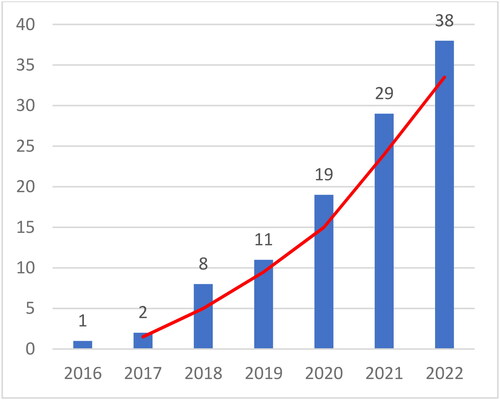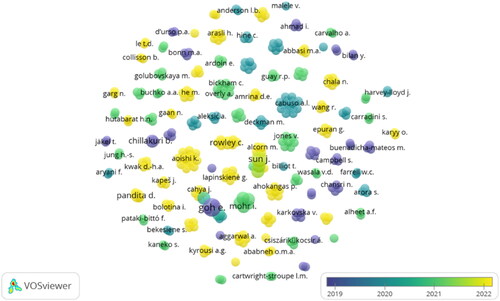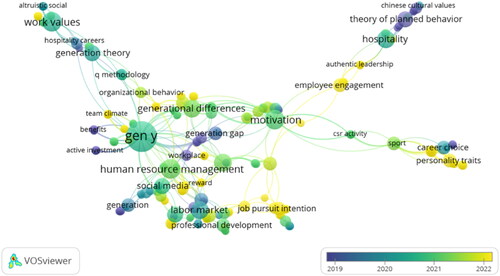Abstract
Recently, Generation Z, born from 1995 to 2010, started entering the labor market and is becoming an important human resource. They will account for 27% of the workforce by 2025, therefore, studying this cohort and how they perceive careers is critically significant. However, literature on Generation Z’s self-perceived careers lacks literature summaries that can shed light on the current landscape of the research field. This study employs bibliometric methodologies to identify current research trends, assess state-of-the-art, and indicate future research direction. Results show 108 papers published between 2016 and 2022. Growth trends, geographical locations, leading sources, and authors are identified. Top documents are indicated, with main and trending topics, which provide suggestions for researchers who conduct research in this area.
Introduction
As the labor market continues to change, a new generational cohort – Generation Z – is steadily joining the workforce and will account for a quarter of the workforce by 2025 (Chillakuri, Citation2020). Born from 1995 to 2012, this generation is still at the age of career starters and young professionals. However, they have already experienced a great deal in their entrance into the labor force. They have navigated a global pandemic, which resulted in sudden, widespread, and distressing job losses. As a result, internships were canceled, job offers revoked, and thriving careers disrupted. It was reported that Gen Z was the most severely affected generation who lost their job or got a pay reduction or an hour at work reduction at the beginning of the pandemic (The Center for Generational Kinetics, Citation2023). Despite all this, the resilient, diverse, and engaged generation persisted and navigated back into a world of hybrid work, the gig economy, or entirely remote work. Right after the pandemic, the world saw waves of Great Resignation, then Quiet Quitting, then mass layoffs by tech giants, and Generation Z either was a part of it or witnessed these phenomena. Consequently, knowledge about their perceptions of careers, e.g. aspirations, preferences, and values, can help inform managers and policymakers to ensure alignment between strategies and the self-perceived careers of Gen Z.
Individuals are collectively called a generation when they were born in the same chronological, social, and historical timeframe and therefore share similar characteristics and behaviors (Twenge et al., Citation2010). Thus, each generation has its own biography, by which the personality of that generation is shaped (Khan & Al-Shibami, Citation2019). Based on this, one of the most distinctive identities in generational theory and research lies in the bracket of the birth year (Anderson & Gettings, Citation2020; Egerová et al., Citation2021), for example, baby boomers born from 1946–1961, Generation X from 1962 to 1979 (Arora et al., Citation2020), and Generation Y, or Millennials, from 1979 to 1994 (Raslie & Ting, Citation2021). As each generation distinct themselves from others in terms of expectations, experiences, values, education, family, lifestyle, and work ethics (Akhras, Citation2019; Tang et al., Citation2020), understanding the new cohort of Generation Z and devising strategies to accommodate them in the workplace assumes significance (Chillakuri, Citation2020). Consequently, the topic of careers for Generation Z has been attracting increasing interest from both scholars and practitioners’ worlds (Benítez-Márquez et al., Citation2022).
With the characteristics of Generation Z who prioritize individualization and diversity (Deloitte, Citation2018), various researchers have investigated these young people’s careers using their own perspectives, for example, Aggarwal et al. (Citation2022), Egerová et al. (Citation2021). However, there has been no literature review on the topic of the Z generation’s careers, specifically from their own viewpoints. The definition of career emphasized the notion of a career as a self-perceived construct, i.e. ‘the individually-perceived sequence of attitudes and behaviors associated with work-related experiences and activities over the span of a person’s life’ (Alexander, Citation2016, p.4). The importance of the self-perceived career has also been long recognized as such a subjective career can be more significant to a person’s response to a situation than the objective career and can influence the goals pursued and the decisions consequently made (Collin, Citation1986). Furthermore, the concept of subjective career success has been increasingly attracting attention from scholars (Ng & Feldman, Citation2014), highlighting the importance of individuals’ self-perceived evaluations and reactions to their careers. Therefore, the lack of a literature review on Generation Z’s self-perceived career is a serious dearth in the understanding of the needs, wants, and perceptions that Gen Z has in their career journey. Therefore, the primary aim of this research is to conduct a review of all previous works regarding the topic of Generation Z’s self-perceived career employing bibliometric methodologies.
The term’ bibliometrics’ was coined by Frunzaru and Cismaru (Citation2018) and aimed at measuring the scientific productivity of scholarly research. This approach of systematically reviewing the literature focuses more on measuring and assessing research productivity, impact, and collaboration in a quantitative manner (Donthu et al., Citation2021). The purpose of this analysis is to synthesize the research topic’s overall trends and patterns. Science mapping, i.e. visualizing bibliometric networks, is also employed as a robust method to examine a wide range of bibliometric networks (Romero & Lado, Citation2021).
In the Human Resource Management field, various works have used bibliometric methods, for example, in the area of green human resource management research or human resource analytics (Qamar & Samad, Citation2021). In the specific career studies area, Chen (Citation2021) also used bibliometric visualization to conduct a taxonomy of career studies between 1990 and 2012. Therefore, this method is deemed to be appropriate to present a systematic overview of the Gen Z self-perceived career literature ().
In particular, the research questions of this study are as follows:
Research question 1: What is the overall volume and growth pattern of publications in Generation Z’s self-perceived career literature? What are the distributions of publications across the different countries?
Research question 2: Who are the top authors in Generation Z’s self-perceived career literature in terms of the number of publications and citations? What are the collaboration patterns in this field?
Research question 3: What are the top sources in Generation Z’s self-perceived career literature?
Research question 4: What are the top documents? What are the main and trending topics?
Materials and method
Methods
The primary research method employed in our study was bibliometrics which aims to explore the intellectual structure of a specific domain in the extant literature (Donthu et al., Citation2021). Science mapping was also used, which is a combination of classification and visualization to create a representation of the research area’s structure by partitioning documents, authors, journals, and keywords into different groups. Visualization is used afterward to create a visual representation of the classification that emerges (Zupic & Čater, Citation2015)
The primary source of data for this study is Elsevier’s Scopus database, one of the most extensive reputable research repositories in the world (Çağlayan Akay et al., Citation2022). Additionally, this database offers wide coverage of journals in multiple disciplines and high-quality standards (Baas et al., Citation2020). In the field of Human Resource Management, Scopus has been widely used in various bibliometric and literature review analyses (Farrukh et al., Citation2021; Qamar & Samad, Citation2021).
Data collection
This research was conducted according to the Preferred Reporting Items for Systematic Reviews and Meta-Analyses (PRISMA). The PRISMA Statement principally embodies a four-phase flow diagram. Firstly, the literature must be thoroughly examined, which results in records. Following that, all records are to be screened through and then filtered by a set of eligibility criteria. Finally, the relevant studies are included in the final dataset, ready for analysis (Moher et al., Citation2009). The information flow through the four steps, as guided by PRISMA, is illustrated in . Initially, the search query is based on the scope of the study with the keywords ‘Generation Z’ and ‘Career’. Synonyms and different parts of speech of such two primary keywords were also collected, listed, and included to ensure the full coverage of our work.
Figure 1. PRISMA diagram describing the collection of research on Generation Z careers from the Scopus database.
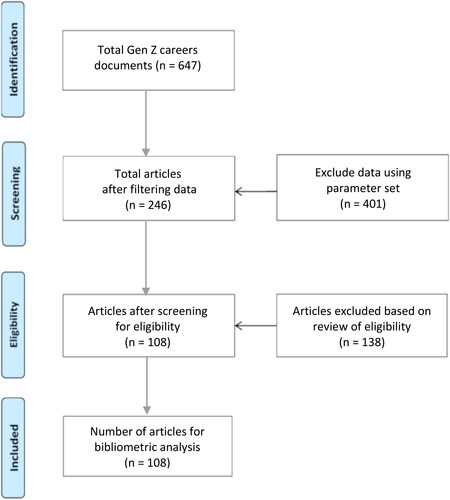
Table 1. Table of synonyms.
The search queries, presented in , were searched based on the title, abstract, and keyword within the Scopus database on January 1, 2023. The first raw data returned 647 documents from 1963 to 2022. After that, the data is filtered by Scopus filters based on broad categories, which reduced the number of total studies to 246 documents. The applied parameters in this phase were: (1) document types included: Article; (2) Language included: English; (3) Subject areas include: Arts and Humanities, Business, Management and Accounting, Decision Sciences, Economics, Econometrics and Finance, Psychology, and Social Sciences.
Table 2. Search queries.
One criterion for inclusion is selecting empirical articles from journals only, which means the results from conference proceedings, conceptual articles, and book chapters have been removed. First, conference proceedings and book chapters shall be eliminated as these do not always guarantee rigid quality compared to a peer-reviewed article, and are not always available for access, for example, Biernacki et al. (Citation2018). Also, this research focuses only on empirical studies because these involve actual data that were taken from Gen Z participants’ perspectives. Therefore, conceptual studies, e.g. Jayathilake et al. (Citation2021), are also removed. As a result, the final database for further analysis comprises 246 articles for final review.
In the next step, to ensure that all works extracted in our search belong to the topic of career from Gen Z’s perspectives, the titles, abstracts, and keywords of all 246 publications were manually read. These works were subsequently re-considered based on the relevance of the document to the topic of investigation in this study, i.e. career-related topics from the lens of Gen Z. A large number of articles, therefore, have been excluded as they may focus on other subjects such as educators (Mahesh et al., Citation2021), manager and HR Department (Chillakuri, Citation2020) rather than Generation Z. In this phase, three authors conducted the analysis separately and met up on a periodical basis to compare, discuss, and reconcile the results. Based on this review of eligibility, 138 publications were removed, leaving the remaining 108 publications to be used for analysis.
Data analysis
The 108 documents were exported from the Scopus database with their bibliographic data. Data analysis first consisted of descriptive statistics, for example, document number by year, country, journal, and author. Also, it included bibliometric analysis such as citation and bibliographic coupling analysis (Ortiz-Pimentel et al., Citation2020; Sakdiyakorn et al., Citation2021). Excel and VOSviewer bibliometric software were used to perform the bibliometric analyses.
Results and discussion
Overall volume and growth pattern
The overall volume and growth pattern of these publications in Gen Z self-perceived career topics are presented in and .
Table 3. The growth trajectory of research on Gen Z’s careers from 2016 to 2022.
Notably, all recorded articles date back to 2016. In 2018, despite quadrupling compared to the previous year, the number of papers on this specific research area continues to be still rather limited in number, with eight articles. It is, however, worth mentioning that the year 2018 also marks the record of the highest cited paper to date, Goh and Lee (Citation2018). The years from 2019 onwards witnessed a radical increase in the number of publications each year, which has shown an increasing interest among scholars attributable to the theoretical and practical implications this research topic might bring (Kamble et al., Citation2021). The explanation for this late start probably lies in the fact that given the most commonly accepted definition of the Gen Z birth cohort’s age bracket (Chillakuri, Citation2020), the oldest ones were born in 1997, which makes 2017 the year when most of this cohort are likely to join the workforce (Leslie et al., Citation2021) and the career topic has become significant for them.
Countries
and illustrate leading countries in this research field in terms of the first author’s affiliation. From the number of publications, it could be seen that this topic arouses scholars’ interest in four continents, i.e. Australia, America, Europe, and Asia. The United States outnumbers other countries in the top list with 26 published papers, which nearly doubles the second-ranked country – the United Kingdom. India emerges with ten publications, while the remaining countries in the top list merely have a one-digit number of articles. Besides, according to the income classification by the World Bank (World Bank, Citation2022), eight out of 12 countries in the table belong to the high-income group and appear to exert remarkably more interest in this particular field.
Figure 3. Geographical distribution of Gen Z’s career publications across different countries in the period from 2016 to 2022.
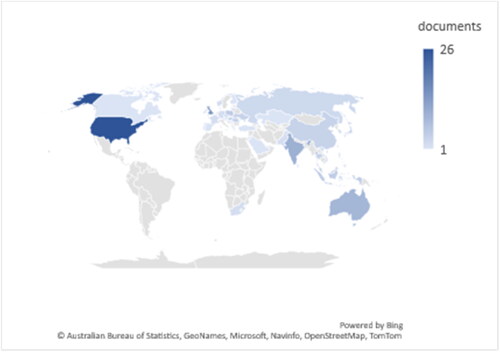
Table 4. Leading countries in GenZ’s Career as counted by the number of publications and citations (2016–2022).
Interestingly, based on citation number, the rank of leading countries has changed. Even though the United States dominates in terms of the number of papers, Australia, with 325 citations, turns out to trigger the highest response for the works, mostly thanks to the article by Goh and Lee (Citation2018). The United Kingdom stays in the top three with a three-digit number of citations, while other European and Asian countries appear to have relatively limited impacts.
Top authors
Our database indicates that between 2016 and 2022, 312 authors contributed 108 papers to the literature on Generation Z’s self-perceived careers. ranks the nine most prolific authors according to their overall number of publications. The literature on Generation Z is in its early phases (Chillakuri, Citation2020), which explains why even the most active author Goh (2018, 2019, 2021) published only four articles, followed by Sun (2021, 2022) with three. The other authors, who equally ranked third on the list, each produced two articles.
Table 5. Leading authors in Gen Z’s careers the literature as accounted by the number of publications and total citations (2016–2022).
also presents the nine most influential authors based on the number of citations of their publications, which reflects their impact and degree of acceptance in the subject fields (Donthu et al., Citation2021). As the most prolific author in the discipline, Goh’s four articles received 266 citations. Lee, a co-author of Goh, has 134 citations for one publication and ranks second. These top authors obtained three-digit citations, while the following seven got between 43 and 68 citations for their publications. Interestingly, Sun, the second most productive author in the field, is not included in the top nine highly cited authors since his three papers receive limited citations, while Lee co-authored only one publication, Goh and Lee (Citation2018) but is recognized as the second most influential scholar.
Collaboration network
The degree of influence of an author is reflected not only through scientific output and citation number but also their collaboration with other authors. shows the map of co-authorship between scholars on the topic of self-perceived careers of Generation Z. Totally, 312 authors from 97 research clusters, of which Goh and Sun form the two largest ones. This is consistent with the leading positions of these two authors in this body of literature. Next, the research clusters of Aoishi, Cabuso, and Rowley are also of considerable size with the collaboration with various researchers. Several smaller groups can also be witnessed, for example, the ones of Ahokangas, Jones, and Bickham.
Figure 4. Co-authorship map of Gen Z’s careers literature (2016–2022) (display 396 authors, threshold 1 article).
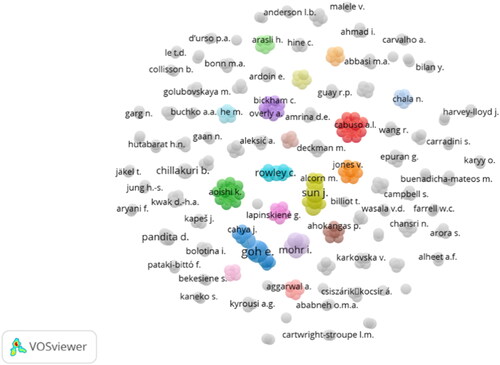
When the collaboration network of authors is analyzed in relation to time in , the brightest clusters represent those who newly published in 2022, and darker nodes represent those who published earlier, around 2019 or before. The largest group of Goh is a well-established one but seems to be less active than other leading groups in recent years. The newly emerging and strong clusters are those of Aoishi, Rowley, and Ahokangas.
Top journals
There was a total of 108 articles published in 85 different journals, covering a variety of research areas and career aspects. This diversity of publication sources indicates that Generation Z’s self-perceived careers are increasingly attracting the attention of scholars from various disciplines. presents the ten most active sources in Scopus Data from 2016 to 2022. Sustainability, a multidisciplinary journal, is the top source with eleven articles. This small number of publications, even in the most active journal, could be explained by Generation Z’s recent entry into adulthood and participation in the labor market (Frunzaru & Cismaru, Citation2018). International Journal of Contemporary Hospitality Management ranks second with four articles, followed by the International Journal of Hospitality Management and Kybernetes, each with two. The top ten journals have contributed almost one-third of all Gen Z’s self-perceived career publications between 2016 and 2022. Regarding the citation count, presented in , the top cited journal is the International Journal of Hospitality Management, with 224 citations which are over four times higher than the second-ranked journal (Sustainability), with 61 citations.
Table 6. Top ten leading sources in Gen Z’s careers research area rated by publication number (2016–2022).
Table 7. Top ten leading sources in Gen Z’s careers research area rated by citations number (2016–2022).
Most influential documents
The most influential articles, recognized by the number of citations (Ding & Cronin, Citation2011), in the body of literature regarding Gen Z’s career, are summarized in . The top two cited papers, both published in the International Journal of Hospitality Management, are the works of Goh in collaboration with other researchers which received 134 and 68 citations, respectively. This information confirms the leading position of this author as the most productive and influential scholar as well as the International Journal of Hospitality Management as the top source of publication in this newly emerging research field.
Table 8. Top ten most influential publications in Gen Z’s careers literature ranked by number of citations (2016–2022).
Among the top ten most cited articles, four of them focus on Generation Z in the hospitality sector (Goh & Lee, Citation2018; Goh & Baum, Citation2021; Goh & Jie, Citation2019; Goh & Kong, Citation2018). This shows a sizeable attention of scholars in the hospitality discipline for this young cohort of the workforce. Furthermore, given the ongoing scarcity of workers in the field globally and the increasing dominance of Generation Z as a major labor force, it is very likely that this research topic might be even of more critical importance in the upcoming future.
Main and trending topics
To figure out the topics frequently investigated by scholars in this body of literature, the co-occurrence map of author keywords is constructed as in . The mapping of 273 keywords reveals some main aspects related to the studies of Gen Z’s career viewpoint. First, the study of Gen Z in comparison with other generations, especially Gen Y, appears to be a prominent one. This trend may reflect the current demand of organizations to address the challenges related to generational differences in the workplace. With the recent entrance of Gen Z to the workforce, some organizations may have four or even five different generations all working together (Benítez-Márquez et al., Citation2022). This diversity may result in conflicts among employees due to generational biases, stereotypes, and misperceptions (Kay, Citation2019) as well as discrepancies in learning styles, beliefs, and communication styles (Arora et al., Citation2020). As a result, the understanding of differences in generations’ work preferences may help organizations manage workforce diversity more effectively. Some other popular topics that might be beneficial to human resource practitioners in attracting, retaining and developing the workforce include Gen Z’s work values, motivation, career choice, and job pursuit intention. Second, the theory that has been used extensively in this body of literature is the theory of planned behavior, and Q-methodology appears to be a specific method that has been employed. Third, the context of the hospitality industry also appears in the map, as highlighted in the previous parts of top journals and top articles. Fourth, social media is reported as an important factor in Gen Z’s career research.
Figure 6. Network visualization map of co-occurrence keywords in GenZ’s careers research field (2016–2022) (total number of keywords: 273).
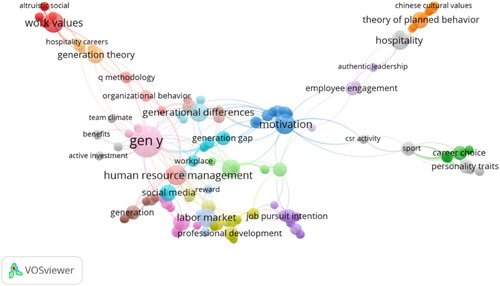
A closer look into the keyword map with a timeline (), in which the lighter nodes are for the topics that have been investigated more recently than the darker ones, sheds light on the trending topics that might attract more attention from researchers in the future. These include employee engagement, personality traits, job pursuit intention, entrepreneurial careers, entrepreneurial intentions, employer attractiveness, and authentic leadership. Researchers who are studying this field or have newly entered can consider these as some starting points to form their research questions and research design.
Conclusion and future research directions
This paper presents a structured review of the self-perceived Generation Z’s careers research field, or in other words, investigating the studies on ‘beauty in the eyes of the beholder’. In regard to research question 1, overall, it shows a newly emerging research field in its early phase with still a limited number of publications and scholars, i.e. 108 empirical articles and 312 authors from 2016 to 2022. This area of research is growing and promising, evidenced by a radical increase in the amount of literature in recent years. The geographic dispersion of the works indicates the United States and the United Kingdom as the hubs of knowledge of Generation Z’s self-perceived career literature. The diffusion of the work into Asia has also strongly emerged with authors from India, Indonesia, and South Korea, though their impacts are still quite limited. For research question 2, the bibliometric analysis reveals some leading positions in the field. First, Goh is recognized as the top author in many aspects: the most productive scholar in terms of article number, the most influential researcher regarding citation number, and a highly collaborative scholar who leads a well-established research cooperation network. In terms of research question 3, Sustainability is the key journal publishing on Gen Z’s career for the number of articles and the Journal of Hospitality and Tourism Management is the most impactful source of publication with the highest level of citations. These should be the outlets that researchers who begin to explore the field should pay attention to so that they can be updated with some of the most significant developments of the concept. Also, the Foci of sources in which Generation Z’s self-perceived career literature was published are diverse, as the sources of documents include journals of multiple disciplines. This implies that a Gen Z’s self-perceived career may be a topic of interest to scholars of various areas, and those who aim to publish their papers can have a broader look at not only those outlets with a scope regarding career or human resource management topics but also journals in other fields, most notably those in Tourism and Hospitality areas.
Regarding researchers who want to enter this research field, the leading documents identified in this study might be a good starting point. These include papers that have been well-established in terms of citations in the research field. They also cover important topics such as the comparison between Generation Z and previous generations (Bejtkovsky, Citation2016), job perceptions (Goh & Baum, Citation2021), motivations (Cho et al., Citation2018), and expectations (Chillakuri, Citation2020).
The limitations of Generation Z’s self-perceived career research field can also be indicated. Firstly, even though a considerable number of scholars contributed intellectually to the field (312 authors in total), this body of literature is still highly fragmented, with the top author only publishing four articles. The limited number of countries involved, i.e. 50 countries, needs consideration. The growth in geographic locations of studies about Generation Z’s career is desired, as data from less developed nations and areas may reveal different perspectives and facilitate the development of Generation Z’s careers from a multi-culturally and globally relevant viewpoint.
Overall, Generation Z’s self-perceived career field is growing and tends to be increasingly relevant when more members of this cohort join the workforce. Significant room for further development still exists given the limited overall output of the field as well as the small number of impactful publications. These figures are expected to grow in the near future, given the potential of this concept as well as the established foundation provided by the existing research. This also suggests various future research directions as below.
Methods
While a bibliometric network offers the advantage of analyzing large amounts of complex bibliographic data easily by focusing on core dimensions of the dataset, it also comes with the drawback of information loss, e.g. the citation network only shows who is citing from whom but cannot identify the reason why this happens (van Eck & Waltman, Citation2014). To gain more detailed insights, future literature review research may include content analysis of important publications. Longitudinal analysis is also recommended to investigate the evolution of Generation Z’s self-perceived career literature over time. By doing so, studies could enhance the existing literature and provide valuable input for managers and policymakers in designing strategies and practices aligned with the young generation’s aspirations and trajectories.
Languages
This analysis is limited to English-language sources while excluding documents in other languages. Therefore, future studies should consider investigating research written in other languages. From the Scopus database, various Generation Z career studies are reported in Russian (Shilova, Citation2021), Spanish (Gutiérrez Arenas et al., Citation2022), or Korean (Chae & Kim, Citation2022). Consequently, it is suggested that future studies may include studies in those languages to gain a multicultural perspective of how Generation Z in different parts of the world perceive their careers.
Data
The primary source of data for this study is limited to Elsevier’s Scopus database, therefore, future research can consider combining data from multiple databases, among which Web of Science is referred to as most preferred in the field of business and management (Sahni & Singh Kaurav, Citation2023).
Research topics for empirical studies
This study’s co-occurrence map of author keywords suggests some promising research topics for researchers conducting empirical studies. These include (1) comparison between generations co-existing in the workplace (2) Generation Z’s work values, motivation, career choice, and job pursuit intention; (3) attracting, retaining, and developing Generation Z; (4) impacts of social media in Gen Z’s career. In addition, more recent research reveals the topics that are attracting attention, including (1) employee engagement; (2) entrepreneurial careers and entrepreneurial intentions; (3) employer attractiveness, and (4) authentic leadership.
Disclosure statement
No potential conflict of interest was reported by the author(s).
Additional information
Notes on contributors
Thanh-Hang Pham
Thanh-Hang Pham is a Ph.D. candidate and Associate Lecturer in RMIT Vietnam University. Her research interests include career orientations, Generation Z, human resource management and entrepreneurship.
Thi Minh-Hang Nguyen
Thi Minh-Hang Nguyen is a lecturer at Faculty of Management and Tourism, Hanoi University. Her research interests include Finance and Banking, Corporate Governance and Sustainability.
Thi-Cam-Tu La
Thi-Cam-Tu La is a Ph.D. candidate at Universiti Teknologi Petronas. Her research interests include Human Resources Management, Higher Education Management, and Employee Sustainable Performance.
Xuan-Quynh Hoang
Xuan-Quynh Hoang is a lecturer at Faculty of Management and Tourism, Hanoi University. Her research interests include Accounting and finance, Corporate governance, Accounting education, and Sustainability reporting.
Seng Kiat Kok
Seng Kiat Kok is Dean of Students, RMIT Vietnam, providing strategic management and leadership in the studentcentered and student-facing domains of the university, particularly, in areas of academic progression, student experiences and student wellbeing. He is research active in the fields of management science, higher education management, entrepreneurship and tourism.
Jung Woo Han
Dr. Jung Woo Han is a senior program manager for the Human Recourse Program and Entrepreneurship minor in The Business School at RMIT Vietnam. During the last few years, he’s been working on employee motivation and green HRM practices in Vietnam’s hospitality sector for young and dynamic workforces and their transformation in HR through combining quantitative and qualitative methods.
Quyen Dang
Dr. Quyen Dang is a lecturer in International Business. She teaches and does research on International Business, Human Resource Management and Knowledge Transfer.
References
- Aggarwal, A., Sadhna, P., Gupta, S., Mittal, A., & Rastogi, S. (2022). Gen Z entering the workforce: Restructuring HR policies and practices for fostering the task performance and organizational commitment. Journal of Public Affairs, 22(3), 1. https://doi.org/10.1002/pa.2535
- Akhras, C. (2019). An exploratory look at a MENA leadership yardstick. International Journal of Recent Technology and Engineering, 8(2 Special Issue 9), 510–15. https://doi.org/10.35940/ijrte.B1111.0982S919
- Alexander, N. (2016). A body in every cellar: The "new violence" movement in Israeli cinema. Jewish Film and New Media, 4(1), 4–24. https://doi.org/10.13110/jewifilmnewmedi.4.1.0004
- Anderson, L. B., & Gettings, P. E. (2020). Examining young adults’ expectations for retirement: An emerging tension. Communication Studies, 71(1), 59–77. https://doi.org/10.1080/10510974.2019.1691619
- Arora, S., Dubey, V., & Vyas, S. (2020). Study of work values of Gen Z students. International Journal of Technology and Globalisation, 8(3/4), 240–265. https://doi.org/10.1504/IJTG.2020.112179
- Baas, J., Schotten, M., Plume, A., Côté, G., & Karimi, R. (2020). Scopus as a curated, high-quality bibliometric data source for academic research in quantitative science studies. Quantitative Science Studies, 1(1), 377–386. https://doi.org/10.1162/qss_a_00019
- Bejtkovsky, J. (2016). The employees of Baby Boomers Generation, Generation X, Generation Y and Generation Z in selected Czech Corporations as conceivers of development and competitiveness in their corporation. Journal of Competitiveness, 8(4), 105–123. https://doi.org/10.7441/joc.2016.04.07
- Benítez-Márquez, M. D., Sánchez-Teba, E. M., Bermúdez-González, G., & Núñez-Rydman, E. S. (2022). Generation Z within the workforce and in the workplace: A bibliometric analysis. Frontiers in Psychology, 12, 1–16. https://doi.org/10.3389/fpsyg.2021.736820
- Çağlayan Akay, E., Yılmaz Soydan, N. T., & Kocarık Gacar, B. (2022). Bibliometric analysis of the published literature on machine learning in economics and econometrics. Social Network Analysis and Mining, 12(1), 109. https://doi.org/10.1007/s13278-022-00916-6
- Chae, J. H., & Kim, Y. S. (2022). A structural equation model of organizational commitment by hospital nurses: The moderating effect of each generation through multi-group analysis [Article]. The Journal of Korean Academic Society of Nursing Education, 28(3), 305–316. https://doi.org/10.5977/jkasne.2022.28.3.305
- Chen, Z. T. (2021). Poetic prosumption of animation, comic, game and novel in a post-socialist China: A case of a popular video-sharing social media Bilibili as heterotopia. Journal of Consumer Culture, 21(2), 257–277. https://doi.org/10.1177/1469540518787574
- Chillakuri, B. (2020). Understanding Generation Z expectations for effective onboarding. Journal of Organizational Change Management, 33(7), 1277–1296. https://doi.org/10.1108/JOCM-02-2020-0058
- Cho, M., Bonn, M. A., & Han, S. J. (2018). Generation Z’s sustainable volunteering: Motivations, attitudes and job performance. Sustainability (Switzerland), 10(5), 1400. Retrieved from https://www.mdpi.com/2071-1050/10/5/1400 https://doi.org/10.3390/su10051400
- Collin, A. (1986). Career development: The significance of the subjective career. Personnel Review, 15(2), 22–28. https://doi.org/10.1108/eb055535
- Gutiérrez Arenas, M., García, A. R., & Reifs Ruíz, R. M. (2022). Generation Z wants to be a Youtuber and/or influencer. Factors that determine this trend [Article]. Revista ICONO 14. Revista Científica de Comunicación y Tecnologías Emergentes, 20(2). https://doi.org/10.7195/ri14.v20i2.1882
- Deloitte. (2018). Welcome to Generation Z, Deloitte webpage, accessed 7 January 2023. https://www2.deloitte.com/content/dam/Deloitte/us/Documents/consumer-business/welcome-to-gen-z.pdf
- Ding, Y., & Cronin, B. (2011). Popular and/or prestigious? Measures of scholarly esteem. Information Processing & Management, 47(1), 80–96. https://doi.org/10.1016/j.ipm.2010.01.002
- Donthu, N., Kumar, S., Pandey, N., & Lim, W. M. (2021). Research constituents, intellectual structure, and collaboration patterns in journal of international marketing: An analytical retrospective. Journal of International Marketing, 29(2), 1–25. https://doi.org/10.1177/1069031X211004234
- Egerová, D., Komárková, L., & Kutlák, J. (2021). Generation Y and Generation Z employment expectations: A generational cohort comparative study from two countries. E + M Ekonomie a Management, 24(3), 93–109. https://doi.org/10.15240/tul/001/2021-03-006
- Farrukh, M., Raza, A., Ansari, N. Y., & Bhutta, U. S. (2021). A bibliometric reflection on the history of green human resource management research. Management Research Review, 45(6), 781–800. https://doi.org/10.1108/MRR-09-2020-0585
- Frunzaru, V., & Cismaru, D. M. (2018). The impact of individual entrepreneurial orientation and education on generation Z’s intention towards entrepreneurship. Kybernetes, 50(7), 1969–1981. https://doi.org/10.1108/K-05-2018-0272
- Goh, E., & Baum, T. (2021). Job perceptions of Generation Z hotel employees towards working in Covid-19 quarantine hotels: The role of meaningful work. International Journal of Contemporary Hospitality Management, 33(5), 1688–1710. https://doi.org/10.1108/IJCHM-11-2020-1295
- Goh, E., & Jie, F. (2019). To waste or not to waste: Exploring motivational factors of Generation Z hospitality employees towards food wastage in the hospitality industry. International Journal of Hospitality Management, 80, 126–135. https://doi.org/10.1016/j.ijhm.2019.02.005
- Goh, E., & Kong, S. (2018). Theft in the hotel workplace: Exploring frontline employees’ perceptions towards hotel employee theft. Tourism and Hospitality Research, 18(4), 442–455. https://doi.org/10.1177/1467358416683770
- Goh, E., & Lee, C. (2018). A workforce to be reckoned with: The emerging pivotal Generation Z hospitality workforce. International Journal of Hospitality Management, 73, 20–28. https://doi.org/10.1016/j.ijhm.2018.01.016
- Jayathilake, H. D., Daud, D., Eaw, H. C., & Annuar, N. (2021). Employee development and retention of Generation-Z employees in the post-COVID-19 workplace: A conceptual framework. Benchmarking: An International Journal, 28(7), 2343–2364. https://doi.org/10.1108/BIJ-06-2020-0311
- Kamble, A., Desai, S., & Abhang, N. (2021). Wearable activity trackers: A structural investigation into acceptance and goal achievements of Generation Z. American Journal of Health Education, 52(5), 307–320. https://doi.org/10.1080/19325037.2021.1955229
- Kay, A. (2019). The future of business ethics and the individual decision maker. In Research in ethical issues in organizations (Vol. 21., pp. 47–63). Emerald Group Publishing Ltd.
- Khan, I. A., & Al-Shibami, A. H. (2019). Generation Z’s learning preferences: Impact on organisational learning and development - A study conducted in a vocational institute in UAE. International Journal of Learning and Change, 11(4), 379–399. https://doi.org/10.1504/IJLC.2019.105646
- Leslie, B., Anderson, C., Bickham, C., Horman, J., Overly, A., Gentry, C., Callahan, C., & King, J. (2021). Generation Z perceptions of a positive workplace environment. Employee Responsibilities and Rights Journal, 33(3), 171–187. https://doi.org/10.1007/s10672-021-09366-2
- Mahesh, J., Bhat, A. K., & Suresh, R. (2021). Are Gen Z values the new disruptor for future educational institutions? Journal of Higher Education Theory and Practice, 21(12), 102–123. https://doi.org/10.33423/jhetp.v21i12.4704
- Biernacki, M., Zarzycka, E., & Krasodomska, J. (2018 Job preferences among Generation Z Students of Accounting [Paper presentation]. Paper Presented at the 32nd IBIMA Conference, Seville, Spain.
- Moher, D., Liberati, A., Tetzlaff, J., & Altman, D. G. (2009). Preferred reporting items for systematic reviews and meta-analyses: The PRISMA statement. BMJ (Clinical Research ed.), 339(jul21 1), b2535–b2535. https://doi.org/10.1136/bmj.b2535
- Ng, T. W. H., & Feldman, D. C. (2014). Subjective career success: A meta-analytic review. Journal of Vocational Behavior, 85(2), 169–179. https://doi.org/10.1016/j.jvb.2014.06.001
- Ortiz-Pimentel, M., Molina, C., & Ronda-Pupo, G. A. (2020). Bibliometric assessment of papers on generations in management and business journals. Scientometrics, 125(1), 445–469. https://doi.org/10.1007/s11192-020-03670-8
- Qamar, Y., & Samad, T. A. (2021). Human resource analytics: A review and bibliometric analysis. Personnel Review, 51(1), 251–283. https://doi.org/10.1108/PR-04-2020-0247
- Raslie, H., & Ting, S. H. (2021). Gen Y and Gen Z communication style. Estudios de Economia Aplicada, 39(1), 1–18. https://doi.org/10.25115/eea.v39i1.4268
- Romero, J., & Lado, N. (2021). Service robots and COVID-19: Exploring perceptions of prevention efficacy at hotels in Generation Z. International Journal of Contemporary Hospitality Management, 33(11), 4057–4078. https://doi.org/10.1108/IJCHM-10-2020-1214
- Sahni, S., & Singh Kaurav, R. P. (2023). What? Why? When? How? Where? Of technology-based bibliometric review. In S. Rana, J. Singh, & S. Kathuria (Eds.), Advancing methodologies of conducting literature review in management domain (Vol. 2, pp. 79–101). Emerald Publishing Limited. https://doi.org/10.1108/S2754-586520230000002005
- Sakdiyakorn, M., Golubovskaya, M., & Solnet, D. (2021). Understanding Generation Z through collective consciousness: Impacts for hospitality work and employment. International Journal of Hospitality Management, 94, 102822. https://doi.org/10.1016/j.ijhm.2020.102822
- Shilova, N. P. (2021). Relationship between significant life events and experiences in adolescence [Article]. Russian Psychological Journal, 18(3), 70–85. https://doi.org/10.21702/RPJ.2021.3.5
- Tang, J., Tosun, C., & Baum, T. (2020). Do Gen Zs feel happy about their first job? A cultural values perspective from the hospitality and tourism industry. International Journal of Contemporary Hospitality Management, 13(12), 4017–4040. https://doi.org/10.1108/IJCHM-04-2020-0261
- The Center for Generational Kinetics. (2023). The state of Gen Z 2023: Gen Z’s expectations, consumer behavior, and life perspectives, accessed 7 January 2023. https://genhq.com/state-of-gen-z-2023/
- Twenge, J. M., Campbell, S. M., Hoffman, B. J., & Lance, C. E. (2010). Generational differences in work values: Leisure and extrinsic values increasing, social and intrinsic values decreasing. Journal of Management, 36(5), 1117–1142. https://doi.org/10.1177/0149206309352246
- van Eck, N. J., & Waltman, L. (2014). Visualizing bibliometric networks. In Ding, Y., Rousseau, R., Wolfram, D. (Eds.), Measuring scholarly impact. Springer. https://doi.org/10.1007/978-3-319-10377-8_13
- World Bank. (2022). World Bank country and lending groups. Retrieved from https://datahelpdesk.worldbank.org/knowledgebase/articles/906519-world-bank-country-and-lending-groups
- Zupic, I., & Čater, T. (2015). Bibliometric methods in management and organization. Organizational Research Methods, 18(3), 429–472. https://doi.org/10.1177/1094428114562629


